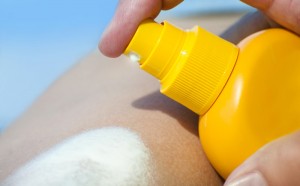 When formulating sunscreens, there is usually a phase with a with a high load of oil. Therefore, the use of emulsifiers is required to keep the formulation stable. However, the use of emulsifiers results in a product with a heavy sensorial, due to the presence of wax and long-chain esters associated with emulsifying surfactants. These ingredients are required to avoid creaming of the formulation.
When formulating sunscreens, there is usually a phase with a with a high load of oil. Therefore, the use of emulsifiers is required to keep the formulation stable. However, the use of emulsifiers results in a product with a heavy sensorial, due to the presence of wax and long-chain esters associated with emulsifying surfactants. These ingredients are required to avoid creaming of the formulation.
Using Polymers to Increase Stability
Another widely used formulating technique is employing synthetic polymers in the water phase. Formulators should chose a synthetic polymer that guarantees greater stability, keeping oil droplets static. The main synthetic polymer recommended for this purpose is acrylates/C10-30 alkyl acrylate crosspolymer. This INCI may cause some confusion, because there is a high number of raw materials with the same ingredient, including Pemulen™ TR-1, Pemulen™ TR-2, Carbopol® Ultrez 21 and Carbopol® ETD 2020. Yet, Pemulen™ TR-2 is the most indicated because it imparts less viscosity to the formulation. This is an advantage when we talk about sunscreen, a product that should spread easily over the skin. Furthermore, Pemulen™ TR-2 is able to stabilize a great part of the formulation’s oil content.
Emulsifier-Free Systems
The first step when formulating an emulsifier-free photoprotector is choosing Pemulen™ TR-2 in a concentration of 0.15 to 0.25 percent. The hydrophobic groups of this polymer will stabilize the oil content, but be careful. In my experience, I noticed that the formulation will keep stable with a sun protection factor (SPF) of up to 30. However, when we increase the oil phase of the screen to obtain a higher SPF, using this polymer is not enough. I also avoid using physical screens such as titanium dioxide and zinc, because they can have an impact on the formulation’s stability. Use only fat-soluble chemical screens. If this results in a low final viscosity of the product, simply associate another polymer, such as carbomers or sodium polyacrylates, to adjust the viscosity.
Working with Acrylates/C10-30 Alkyl Acrylate Crosspolymer
It may be difficult to formulate with this polymer without the correct guidance, because there are specific techniques to be followed in order to correctly dissipate the polymer in water. One of the techniques available is simple but time-consuming: Add the polymer to water with constant mixing. Allow 8 to 12 hours of hydration, depending on the quantity to be produced and the contact area. It is recommended to use a very large container in order to have a larger area to powder the polymer.
Another technique is to use a dissolver stirrer, which provides radial flow for drawing the material to be mixed from the top and the bottom while creating high turbulence and high shearing forces for particle reduction.In the industry, we use a colloidal mill to ensure the reduction of the polymer particles.
Rinse Resistance
Another advantage of sunscreens without conventional emulsifiers is that the dispersed oil phase is not in the form of micelles, and, therefore, it repels water. The result is a higher resistance to rinse after applying the product on the skin, when compared to photoprotectors formulated with conventional o/w emulsifiers.
The correct use of these techniques allows the formulation of a product with a really light sensorial. This is mainly recommended for body photoprotectors, because the product will have an easy spreadability that we can call “light-feeling.”
Leia este artigo em português
About the Author:
 Lucas Portilho is a cosmetology expert with IPUPO, the union of high-level professionals who currently work in the cosmetic markets throughout Brazil. Their main objective to bring and share knowledge to enable health professionals through updated teaching methods at the highest level. Postgraduate professionals from recognized institutions have higher wages and occupy ever more important positions within companies.
Lucas Portilho is a cosmetology expert with IPUPO, the union of high-level professionals who currently work in the cosmetic markets throughout Brazil. Their main objective to bring and share knowledge to enable health professionals through updated teaching methods at the highest level. Postgraduate professionals from recognized institutions have higher wages and occupy ever more important positions within companies.
The views, opinions and technical analyses presented here are those of the author or advertiser, and are not necessarily those of ULProspector.com or UL Solutions. The appearance of this content in the UL Prospector Knowledge Center does not constitute an endorsement by UL Solutions or its affiliates.
All content is subject to copyright and may not be reproduced without prior authorization from UL Solutions or the content author.
The content has been made available for informational and educational purposes only. While the editors of this site may verify the accuracy of its content from time to time, we assume no responsibility for errors made by the author, editorial staff or any other contributor.
UL Solutions does not make any representations or warranties with respect to the accuracy, applicability, fitness or completeness of the content. UL Solutions does not warrant the performance, effectiveness or applicability of sites listed or linked to in any content.



Will using maximum level of UV filters irritate the skin?